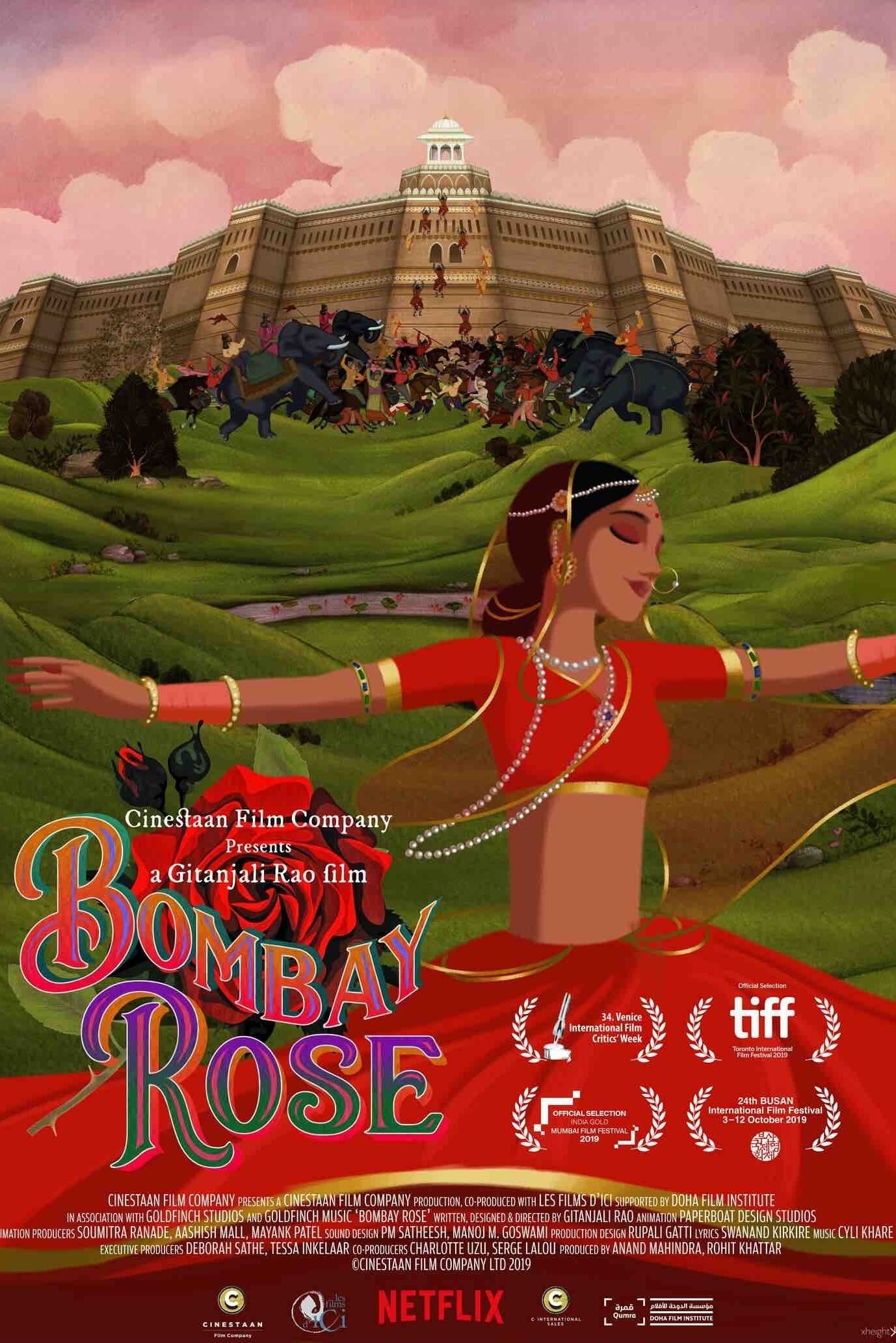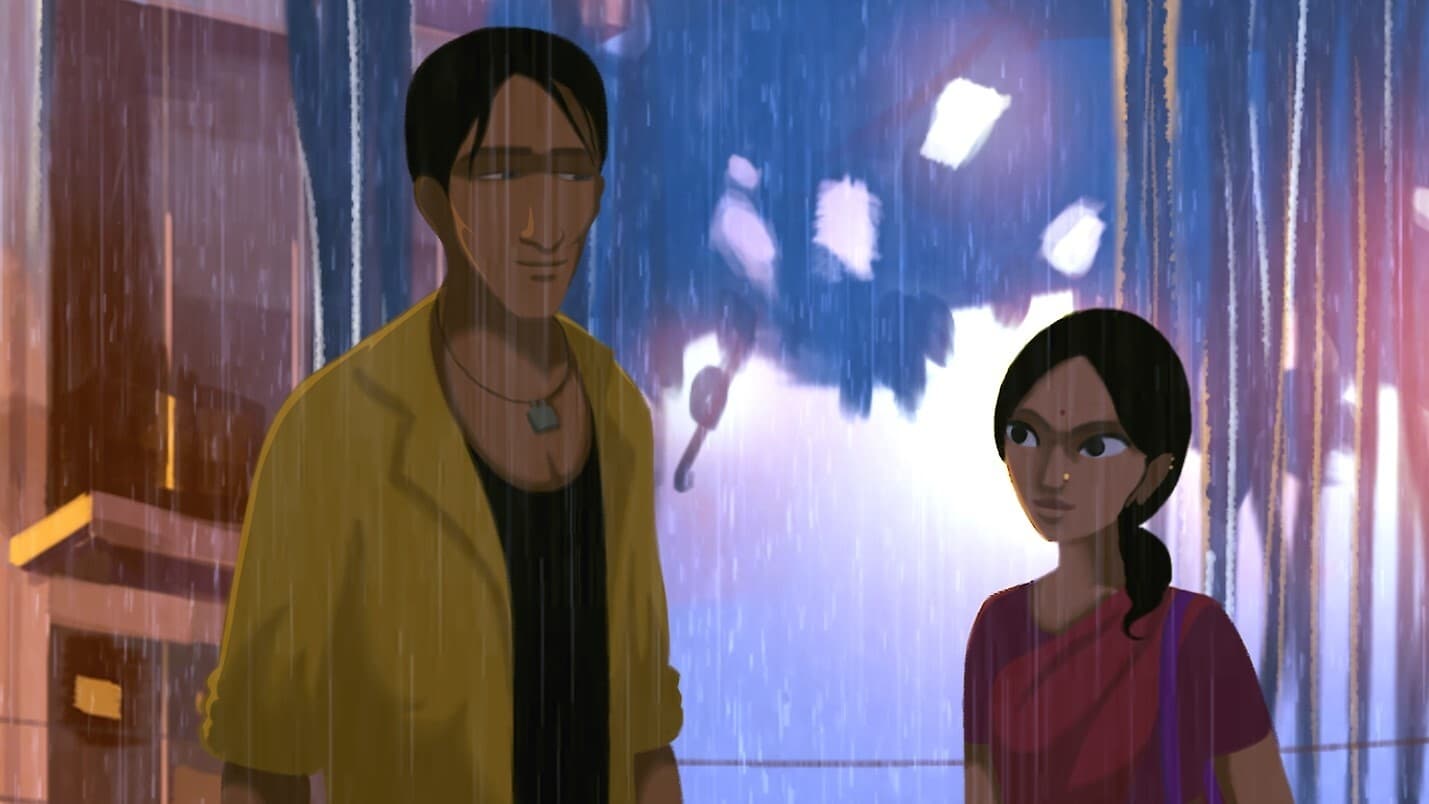
Salaam Bombay
I'd be lying my head off if I said that there was no room for improving any of it, but I do think the correct disposition towards Bombay Rose, whatever we want to say about its final quality, is to be suitably impressed that the thing exists at all. There's a crew that put this together and all (most of them related to sound and music), but the entire 93-minute animated feature is basically a DIY project for director-plus-several-other-roles Gitanjali Rao, who has previously made a couple of short films entirely by herself, which must have made this a relatively luxurious project, what with its 20-person staff (this number later increased, but the total number of humans who worked on Bombay Rose would barely fill a department at a big Hollywood animation studio), working in software no fancier than Photoshop, After Effects, and Flash. And unlike most "I whipped this up in my garage"-scaled animation projects, it's neither limited in movement nor primitive in design; it's actually quite a rich, lush collection of faux-oil paintings painstakingly created using digital painting software, put into constant motion through a busy, bustling vision of the titular city, past and present (which, I guess technically, there is no such thing as Bombay in the present, but I assume you know what I mean).
As for the story Rao tells through this story, well, that's where we get to the stuff that there's room to improve. Bombay Rose has quite a great deal of story to divide between its characters, and it only does a halfway decent job of forcing all of that story into a shape. At the very simplest, this is the story of Kamala (Cyli Khare) and Salim (Amit Deondi), a pair of young folks trying to survive the mean streets of Mumbai - she's Hindu and is a dancer being pushed into prostitution, he's a homeless Muslim flower seller - who eventually fall in love despite their apparently insurmountable social differences. The minute we make it even a little bit less simple, the characters start to pile up fast and furious, and so do their subplots: Kamala's little sister Tara (Gargi Shitole) who befriends a mute orphan boy who washes dishes, Ms. D'Souza (Amardeep Jha), lost in her nostalgic reminiscence and widowhood, old antiques seller Anthony Pereira (Shishir Sharma). The characters are all tied together in a kind of hyperlink narrative, but mostly the only reason they need to be in the same movie is because of a shared vibe: these are all people on the edges of the world, struggling to find place in the sprawling cultural polyglot of Mumbai, all of them carried away by romantic visions of a past, real or imaginary.
When Bombay Rose is at its best, it's because it's using the expressive powers of animation to do the work of exploring that nostalgia, creating a visual schema that keeps getting tweaked and re-used throughout the film. A character will walk down the street, and the space around them will invisibly be replaced by the past - Ms. D'Souza's memories of the handsomeness of a more British Bombay, Kamala's vision of herself proudly striding as a fine lady of the late Mughal Empire, Salim lost in visions of the overwrought classical Bollywood romantic movies that fire his imagination. Each of these moods is styled a little differently - mildly sepia-toned monochrome, like a dying old photograph, for the old Bombay that was, the distinct profile-based flatness of Mughal art for Kamala's fantasies. The film deftly uses editing to blur realities together, so that at points Kamala confuses Salim and a handsome matinee idol from those same Bollywood romances; a recurring motif finds the two young lovers literally losing sight of everybody but each other, as the backgrounds and crowd characters are dissolved out of the frame one at a time.
It's a very lovely, very fluid way of using animation to creative a fuzziness between daydreams and the real world (and specifically digital animation at that; it works in part because all of the visual elements are digital layers that can be easily manipulated independently of each other), and then there's the matter of the rich, colorful, seemingly textured drawings themselves. Not all of these meld perfectly: the robotic smoothness of Flash animation and the smeary, soft edges of the painted colors don't like to play together at all, leading to moments where a character's delicately shaded moving arm seems to slice mechanically against the delicately shaded background (though it only flat-out broke the movie for me once, when a streetcar slides across the background, both of them looking richly voluminous, both seeming horribly flat and thin in the movement). Still, this is bold as hell even when it's not working, and when it is working, it's as beautiful as any similarly-constructed piece of animation I've seen. The film was laboriously created over two years, and you can feel that labor; the film benefits from it immensely.
But then there's that script. It's not bad. And I can't be too upset at it, given how it facilitates all of that smooth, flowing achronological animation. The thing is, what structure the story has is because of that animation, which unites certain moments through visual echoes or outright repetitions; it certainly has no structure thanks to the script, which basically dumps plot points out of a wheelbarrow and spreads them around a bit to make sure we can see all of them. Bombay Rose routinely loses track of its characters, particularly Kamala and Salim, who are obviously the protagonists but are also unceremoniously dropped for long stretches without warning and seemingly without any purpose. There's simply no shape to the narrative, often no clarity at all; without there even being any particularly complicated twists or turns, parts of the story still somehow manage to be confusing, simply because they show up randomly and depart just as randomly.
The film thus can never be more than a simple mood piece, and it is one; a very lovely, moving mood piece, at that, especially with the animation creating a contrast between romantic nostalgia and the unyielding urban chaos of a living city like Bombay simply in its textures and colors. But it's so cluttered and messy at character drama that it feels like something is missing to anchor that mood in something human. Still, this is an unmistakable aesthetic achievement: I'm eager as hell to see where Rao goes next, just as I hope that her work here manages to inspire a few talented imitators.
As for the story Rao tells through this story, well, that's where we get to the stuff that there's room to improve. Bombay Rose has quite a great deal of story to divide between its characters, and it only does a halfway decent job of forcing all of that story into a shape. At the very simplest, this is the story of Kamala (Cyli Khare) and Salim (Amit Deondi), a pair of young folks trying to survive the mean streets of Mumbai - she's Hindu and is a dancer being pushed into prostitution, he's a homeless Muslim flower seller - who eventually fall in love despite their apparently insurmountable social differences. The minute we make it even a little bit less simple, the characters start to pile up fast and furious, and so do their subplots: Kamala's little sister Tara (Gargi Shitole) who befriends a mute orphan boy who washes dishes, Ms. D'Souza (Amardeep Jha), lost in her nostalgic reminiscence and widowhood, old antiques seller Anthony Pereira (Shishir Sharma). The characters are all tied together in a kind of hyperlink narrative, but mostly the only reason they need to be in the same movie is because of a shared vibe: these are all people on the edges of the world, struggling to find place in the sprawling cultural polyglot of Mumbai, all of them carried away by romantic visions of a past, real or imaginary.
When Bombay Rose is at its best, it's because it's using the expressive powers of animation to do the work of exploring that nostalgia, creating a visual schema that keeps getting tweaked and re-used throughout the film. A character will walk down the street, and the space around them will invisibly be replaced by the past - Ms. D'Souza's memories of the handsomeness of a more British Bombay, Kamala's vision of herself proudly striding as a fine lady of the late Mughal Empire, Salim lost in visions of the overwrought classical Bollywood romantic movies that fire his imagination. Each of these moods is styled a little differently - mildly sepia-toned monochrome, like a dying old photograph, for the old Bombay that was, the distinct profile-based flatness of Mughal art for Kamala's fantasies. The film deftly uses editing to blur realities together, so that at points Kamala confuses Salim and a handsome matinee idol from those same Bollywood romances; a recurring motif finds the two young lovers literally losing sight of everybody but each other, as the backgrounds and crowd characters are dissolved out of the frame one at a time.
It's a very lovely, very fluid way of using animation to creative a fuzziness between daydreams and the real world (and specifically digital animation at that; it works in part because all of the visual elements are digital layers that can be easily manipulated independently of each other), and then there's the matter of the rich, colorful, seemingly textured drawings themselves. Not all of these meld perfectly: the robotic smoothness of Flash animation and the smeary, soft edges of the painted colors don't like to play together at all, leading to moments where a character's delicately shaded moving arm seems to slice mechanically against the delicately shaded background (though it only flat-out broke the movie for me once, when a streetcar slides across the background, both of them looking richly voluminous, both seeming horribly flat and thin in the movement). Still, this is bold as hell even when it's not working, and when it is working, it's as beautiful as any similarly-constructed piece of animation I've seen. The film was laboriously created over two years, and you can feel that labor; the film benefits from it immensely.
But then there's that script. It's not bad. And I can't be too upset at it, given how it facilitates all of that smooth, flowing achronological animation. The thing is, what structure the story has is because of that animation, which unites certain moments through visual echoes or outright repetitions; it certainly has no structure thanks to the script, which basically dumps plot points out of a wheelbarrow and spreads them around a bit to make sure we can see all of them. Bombay Rose routinely loses track of its characters, particularly Kamala and Salim, who are obviously the protagonists but are also unceremoniously dropped for long stretches without warning and seemingly without any purpose. There's simply no shape to the narrative, often no clarity at all; without there even being any particularly complicated twists or turns, parts of the story still somehow manage to be confusing, simply because they show up randomly and depart just as randomly.
The film thus can never be more than a simple mood piece, and it is one; a very lovely, moving mood piece, at that, especially with the animation creating a contrast between romantic nostalgia and the unyielding urban chaos of a living city like Bombay simply in its textures and colors. But it's so cluttered and messy at character drama that it feels like something is missing to anchor that mood in something human. Still, this is an unmistakable aesthetic achievement: I'm eager as hell to see where Rao goes next, just as I hope that her work here manages to inspire a few talented imitators.
Categories: animation, indian cinema, love stories






